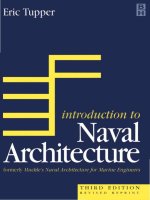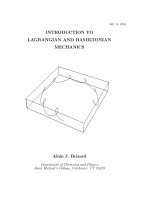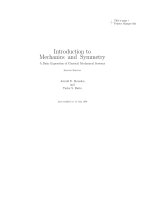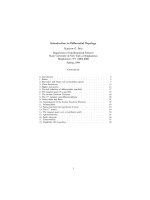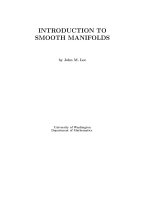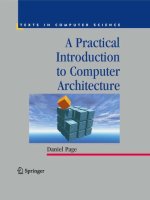lipovski, g. j. (1999). introduction to microcontrollers - architecture
Bạn đang xem bản rút gọn của tài liệu. Xem và tải ngay bản đầy đủ của tài liệu tại đây (28.2 MB, 417 trang )
Introduction
to
Microcontrollers
Architecture,
Programming,
and
Interfacing
of the
Motorola
68HC12
Academic Press Series
in
Engineering
Series
Editor
J.
David
Irwin
Auburn
University
Designed
to
bring together interdependent topics
in
electrical engineering, mechanical
engineering, computer engineering,
and
manufacturing,
the
Academic Press Series
in
Engineering provides state-of-the-art handbooks, textbooks,
and
professional reference
books
for
researchers, students,
and
engineers. This
series
provides readers with
a
com-
prehensive
group
of
books essential
for
success
in
modem
industry.
A
particular emphasis
is
given
to the
applications
of
cutting-edge research. Engineers, researchers,
and
students
alike will
find the
Academic Press Series
in
Engineering
to be an
indispensable part
of
their
design toolkit.
Published books
in the
series:
Industrial
Controls
and
Manufacturing,
1999,
E.
Kamen
DSP
Integrated
Circuits,
1999,
L.
Wanhammar
Time
Domain
Electromagnetics,
1999,
S. M. Rao
Single-
and
Multi-Chip
Microcontroller
Interfacing
for the
Motorola
68HC12, 1999,
G. J.
Lipovski
Control
in
Robotics
and
Automation, 1999,
B. K.
Ghosh,
N. Xi, T. J.
Tarn
Soft
Computing
and
Intelligent Systems, 1999,
N. K.
Sinha,
M. M.
Gupta
Introduction
to
Microcontrollers
Architecture, Programming,
and
Interfacing
of the
Motorola
68HC12
G.
Jack Lipovski
Department
of
Electrical
and
Computer Engineering
University
of
Texas
Austin,
Texas
ACADEMIC
PRESS
A
Harcourt
Science
and
Technology Company
San
Diego London Boston
New
York Sydney Tokyo Toronto
This book
is
printed
on
acid-free paper.
©
Copyright
©
1999
by
Academic Press
All
rights
reserved.
No
part
of
this publication
may be
reproduced
or
transmitted
in any
form
or by any
means, electronic
or
mechanical, including photocopy, recording,
or
any
information storage
and
retrieval system, without
permission
in
writing
from
the
publisher.
Academic Press
A
Harcourt Science
and
Technology
Company
525 B.
St., Suite 1900,
San
Diego, California
92101-4495,
USA
Academic
Press
24-28
Oval Road, London
NW1
7DX,
UK
/>Library
of
Congress
Catalog
Card
Number:
99-65099
ISBN:
0-12-451831-1
Printed
in the
United States
of
America
99
00 01 02 03 DS 9 8 7 6 5 4 3 2 1
Disclaimer:
This eBook does not include the ancillary media that was
packaged with the original printed version of the book.
Dedicated
to my
father,
Joseph Lipovski
LIMITED
WARRANTY
AND
DISCLAIMER
OF
LIABILITY
ACADEMIC
PRESS
("AP")
AND
ANYONE ELSE
WHO HAS
BEEN INVOLVED
IN THE
CREATION
OR
PRODUCTION
OF THE
ACCOMPANYING CODE ("THE
PRODUCT")
CAN-
NOT AND DO NOT
WARRANT
THE
PERFORMANCE
OR
RESULTS
THAT
MAY
BE
OBTAINED
BY
USING
THE
PRODUCT.
THE
PRODUCT
IS
SOLD
"AS IS"
WITHOUT WAR-
RANTY
OF ANY
KIND (EXCEPT
AS
HEREAFTER DESCRIBED), EITHER EXPRESSED
OR
IMPLIED,
INCLUDING,
BUT
NOT
LIMITED
TO, ANY
WARRANTY
OF
PERFORMANCE
OR
ANY
IMPLIED WARRANTY
OF
MERCHANTABILITY
OR
FITNESS
FOR ANY
PARTIC-
ULAR
PURPOSE.
AP
WARRANTS ONLY THAT
THE
MAGNETIC
DISK(S)
ON
WHICH
THE
CODE
IS
RECORDED
IS
FREE FROM
DEFECTS
IN
MATERIAL
AND
FAULTY WORK-
MANSHIP UNDER
THE
NORMAL
USE AND
SERVICE
FOR A
PERIOD
OF
NINETY (90)
DAYS
FROM
THE
DATE
THE
PRODUCT
IS
DELIVERED.
THE
PURCHASER'S SOLE
AND
EXCLUSIVE REMEDY
IN THE
EVENT
OF A
DEFECT
IS
EXPRESSLY LIMITED
TO
EITHER REPLACEMENT
OF THE
DISK(S)
OR
REFUND
OF THE
PURCHASE PRICE,
AT
AP'S SOLE DISCRETION.
IN
NO
EVENT, WHETHER
AS A
RESULT
OF
BREACH
OF
CONTRACT, WARRANTY
OR
TORT (INCLUDING NEGLIGENCE), WILL
AP
OR
ANYONE
WHO HAS
BEEN INVOLVED
IN
THE
CREATION
OR
PRODUCTION
OF THE
PRODUCT
BE
LIABLE
TO
PURCHASER
FOR ANY
DAMAGES, INCLUDING
ANY
LOST
PROFITS,
LOST SAVINGS
OR
OTHER
INCIDENTAL
OR
CONSEQUENTIAL DAMAGES ARISING
OUT OF THE USE OR
INABILI-
TY
TO USE THE
PRODUCT
OR ANY
MODIFICATIONS THEREOF,
OR DUE TO THE
CON-
TENTS
OF THE
CODE, EVEN
IF AP HAS
BEEN ADVISED
OF THE
POSSIBILITY
OF
SUCH
DAMAGES,
OR FOR ANY
CLAIM
BY ANY
OTHER
PARTY.
ANY
REQUEST
FOR
REPLACEMENT
OF A
DEFECTIVE DISK MUST
BE
POSTAGE
PRE-
PAID
AND
MUST
BE
ACCOMPANIED
BY
THE
ORIGINAL DEFECTIVE
DISK,
YOUR
MAILING ADDRESS
AND
TELEPHONE NUMBER,
AND
PROOF
OF
DATE
OF
PURCHASE
AND
PURCHASE PRICE. SEND SUCH REQUESTS, STATING
THE
NATURE
OF
THE
PROBLEM,
TO
ACADEMIC
PRESS CUSTOMER SERVICE,
6277
SEA
HARBOR DRIVE,
ORLANDO,
FL
32887,
1-800-321-5068.
AP
SHALL
HAVE
NO
OBLIGATION
TO
REFUND
THE
PURCHASE PRICE
OR TO
REPLACE
A
DISK
BASED
ON
CLAIMS
OF
DEFECTS
IN
THE
NATURE
OR
OPERATION
OF
THE
PRODUCT.
SOME STATES
DO NOT
ALLOW LIMITATION
ON
HOW
LONG
AN
IMPLIED
WARRANTY
LASTS,
NOR
EXCLUSIONS
OR
LIMITATIONS
OF
INCIDENTAL
OR
CONSEQUENTIAL
DAMAGE,
SO THE
ABOVE LIMITATIONS
AND
EXCLUSIONS
MAY
NOT
APPLY
TO
YOU.
THIS
WARRANTY
GIVES
YOU
SPECIFIC
LEGAL RIGHTS,
AND YOU MAY
ALSO
HAVE
OTHER
RIGHTS WHICH
VARY
FROM JURISDICTION
TO
JURISDICTION.
THE
RE-EXPORT
OF
UNITED STATES ORIGIN SOFTWARE
IS
SUBJECT
TO THE
UNITED
STATES
LAWS UNDER
THE
EXPORT ADMINISTRATION
ACT OF
1969
AS
AMENDED.
ANY
FURTHER
SALE
OF THE
PRODUCT SHALL
BE IN
COMPLIANCE WITH
THE
UNIT-
ED
STATES DEPARTMENT
OF
COMMERCE ADMINISTRATION
REGULATIONS.
COM-
PLIANCE WITH SUCH REGULATIONS
IS
YOUR RESPONSIBILITY
AND
NOT
THE
RESPONSIBILITY
OF AP.
Contents
Preface
x i
List
of
Figures
xiv
List
of
Tables
xx
Acknowledgments
xxi
About
the
Author xxii
1
Basic Computer Structure
and the
6812
1
1.1
Basic Computer Structure
1
1.2
The
Instruction
4
1.3
A Few
Instructions
and
Some Simple Programs
8
1.4
MC68HC812A4
and
MC68HC912B32 Organizations
16
1.5
Variable Word Width
19
1.6
Summary
and
Further Reading
21
Problems
23
2
The
Instruction
Set 27
2.1
Move Instructions
28
2.2
Arithmetic Instructions
34
2.3
Logic Instructions
38
2.4
Edit Instructions
41
2.5
Control instructions
42
2.6
Input-Output Instructions
49
2.7
Special
Instructions
49
2.8
Remarks
51
Problems
53
3
Addressing
5 7
3.1
Op
Code Byte Addressing Modes
58
.,2
Post-Byte Index Addressing Modes
60
3.3
Relative Addressing
and
Position Independence
67
3.4
Stack Index
Addressing,
Reentrancy,
and
Recursion
71
3.5
Examples
76
3.6
Architectural Notions
of
Addressing
78
vii
i
Table
of
Contents
3.7
Summary
81
Problems
82
4
Assembly Language
Programming
87
4.1
Introductory Example
and
Assembler Printout
89
4.2
Assembler Directives
92
4.3
Mechanics
of a
Two-Pass Assembler
96
4.4
Character String Operations
99
4.5 A
Simplified Two-Pass Assembler
103
4.6
Summary
107
Problems
109
5
Advanced
Assemblers,
Linkers,
and
Loaders
119
5.1
Cross Assemblers
and
Downloaders
119
5.2
Relocatable Assemblers
and
Loaders
123
5
3
Conditional Assemblers
125
5.4
Macro Assemblers
127
5.5
Documentation
130
5.6
Summary
132
Problems
133
6
Assembler
Language
Subroutines
137
6.1
Local Variables
139
6.2
Passing Parameters
149
6.3
Passing Arguments
by
Value, Reference,
and
Name
162
6.4
Calling
and
Returning Mechanisms
163
6.5
Summary
172
Problems
173
7
Arithmetic
Operations
179
7.1
Multiplication
and
Division
180
7.2
Integer Conversion
183
7.3
From Formulas
to
Subroutine Calls
191
7.4
Long Integer Arithmetic
196
7.5
Floating-Point
Arithmetic
and
Conversion 20.1
7.6
Fuzzy Logic
210
7.7
Summary
215
Problems
217
8
Programming
in C and C++
221
8.1
Compilers
and
Interpreters
221
8.2
Operators
and
Assignment Statements
223
8.3
Conditional
and
Loop Statements
226
Table
of
Contents
ix
8.4
Constants
and
Variables
227
8.5
Procedures
and
Their Arguments
231
8.6
An
Example
233
8.7
Object-Oriented Programming
in C++ 236
8.8
Summary
245
Problems
246
9
Implementation
of C
Procedures
253
9.1
Global
and
Local Variables
254
9.2
Expressions
and
Assignment Statements
257
9.3
Conditional Statements
265
9.4
Loop Statements, Arrays,
and
Structs
274
9.5
Procedure Calls
and
Arguments
279
9.6
Examples
from
Character String Procedures
282
9.7
Summary
286
Problems
287
10
Elementary
Data
Structures
291
10.1
What
a
Data Structure
Is 291
10.2 Indexable Data Structures
293
10.3 Sequential Data Structures
298
10.4 Linked
List
Structures
304
10.5
Summary
310
Problems
311
11
Input/Output
317
11.1
Input
and
Output Devices
317
11.2
Parallel Ports
320
11.3
Input
and
Output Software
322
11.4
Synchronization Hardware
325
11.5
Gadfly
Synchronization
326
11.6
Interrupt Synchronization
329
11.7
Analog-to-Digital
and
Digital-to-Analog
Conversion
334
11.8
UART
Protocol
337
11.9
Summary
and
Further Reading
340
Problems
341
12
Other Microcontrollers
349
12.1
The
6811
349
12.2
The
6808
352
12.3
The
6805
356
12.4
The
68300 Series
358
12.5
The
500
Series
367
x
Table
of
Contents
12.5
The
M-CORE
Series
370
12.7
Selecting
a
Microcontroller
for an
Application
374
12.8 Summary
375
Problems
377
Appendices
Appendix
1:
Number Representations
and
Binary Arithmetic
381
A
1.1
Number Representations
381
A
1.2
Binary Arithmetic
382
A
1.3
Remarks
385
Problems
386
Appendix
2:
Using
HiWare
CD-ROM
387
A2.1 Loading HiWare Software
387
A2.2
Opening
the
HiWare Toolbox
387
A2.3 Running Examples From
the
ManualProgramFolder
387
A2.4
Running Examples From
the
AssemblyProgramFolder
388
A2.5
Downloading
to
a'B32
Board
389
A2.6
POD-Mode
BDM
Interface
389
A2.7
Techniques
for
HiWare Tools
390
Index
391
Preface
xi
PREFACE
Programming
is an
essential engineering skill.
To
almost
any
engineer,
it is as
important
as
circuit design
to an
electrical engineer,
as
statistics
to a
civil engineer,
and
as
heat transfer
to a
chemical engineer.
The
engineer
has to
program
in
high-level
languages
to
solve problems.
He or she
also should
be
able
to
read assembly-language
programs
to
understand what
a
high-level language
does.
Finally,
he or she
should
understand
the
capabilities
of a
microcontroller because they
are
components
in
many
systems designed, marketed,
and
maintained
by
engineers.
The
first
goal
of
this book
then
is to
teach engineers
how a
computer executes instructions.
The
second goal
is to
teach
the
engineer
how a
high-level language statement converts
to
assembler language.
A
final
goal
is to
teach
the
engineer what
can be
done
on a
small computer
and how the
microcomputer
is
interfaced
to the
outside world. Even
the
nonprogramming
engineer
should
understand these
issues.
Although this book
is
written
for
engineers,
it
will
serve
equally
well
for
anyone, even
hobbyists,
interested
in
these goals.
The
reader
is
taught
the
principles
of
assembly-language programming
by
being
shown
how to
program
a
particular microcomputer,
the
Motorola
6812.
The
important
thing about
the
6812
is
that
it has a
straightforward
yet
powerful instruction set, midway
between
smaller
and
more powerful microcontrollers; from
it the
reader
can
adjust
to
these
smaller
or
more powerful
microcontrollers.
The
best
way to
learn
these
principles
is
to
write
a lot of
programs, debug them,
and see
them work
on a
real
microcontroller.
This hands-on
experience
can be
inexpensively
obtained
on the
6812.
Several
6812
boards,
which
do
everything described
in
this book,
are
available
for
under $100. (This
price
doesn't include
the
personal computer that hosts
the
6812 target system.)
The
following discussion outlines
the
book
and
explains several decisions
that
were
made when
we
wrote
the
book. Optional chapters
are
available
for
readers
having
various
interests.
The
main skills taught
in
each chapter
are
summarized.
Chapters
1 to 3
discuss programming using hand-translated machine
code,
and the
implementation
of
machine instructions
in an
idealized microcontroller.
The
assembler
is
not
introduced
until
Chapter
4.
This gives
the
engineering student
a
fine
feeling
for the
machine
and how it
works,
and
helps
him or her
resolve problems encountered later with
timing
in
input/output programming
or
with
the use of
addressing modes
in
managing
data structures. Chapter
1
explains
how a
microprocessor
interacts
with
the
memory
and
how
it
executes
the
instruction cycle.
The
explanation focuses
on a
microcomputer
and
is
simplified
to
provide just enough background
for the
remainder
of the
text.
Simple
instructions
and
elementary programs
are
introduced next. Pointing
out
that there
is no
best
program
to
solve
a
problem,
Chapter
1
observes what makes
a
good program
and
encourages
the
reader
to
appreciate good
programming
style.
A
discussion
of the
available
organizations
of
6812
microcontrollers concludes this chapter.
In
Chapter
2, the
main concept
is the
alternative forms
of the
same kind
of
instruction
on the
6812. Rather than listing
the
instructions
alphabetically,
as is
desirable
in a
reference book,
we
group together instructions that perform
the
same type
of
function.
Our
groups
are the
classical
ones,
namely,
the
move,
arithmetic,
logical,
edit,
control,
and
input/output groups. Although other groupings
are
also useful, this
one
seerns
to
encourage
the
student
to try
alternative instructions
as a
way
of
looking
for
the
best instruction
for his or her
purpose.
The
6812
has an
extensive
set of
addressing
modes
that
can be
used
with
most instructions; these
are
covered
in
Chapter
3, The
.v/7
Preface
different
addressing modes
are
introduced with
a
goal
of
explaining
why
these modes
are
useful
as
well
as how
they work. Examples
at the end of the
chapter illustrate
the use of
these
modes with
the
instructions introduced
in
Chapter
2.
The end of
Chapter
3
shows
the use of
program-relative addressing
for
position
independence
and the use of
stack addressing
for
recursion
and
reentrancy.
Chapters
4 to 6
show
how a
program
can be
more easily written
in
assembler
and
the
high-level
C
language
and
translated into machine code
by an
assembler. Chapter
4
introduces
the
assembler, explains assembler directives
and
symbolic
addresses,
and
introduces
limitations
of
forward referencing
in a
two-pass assembler. Assembly
language
examples that build
on the
examples
from
previous chapters conclude Chapter
4.
Chapter
5,
which
may be
omitted
if the
reader
is not
going
to
write
assembler
language
programs, provides insights needed
by
programmers
who
write large assembler
language
programs.
A
general discussion
of
related programs, including macro,
conditional,
and
relocatable assemblers
and
linkers,
is
given.
Chapter
6
develops
assembler
language
subroutines.
It
illustrates
techniques used
in
assembler language
at an
implementation level (such
as
passing arguments
in
registers).
The
tradeoffs between macros
and
subroutines
as a
means
to
insert
the
same
program
segment into
different
places
in a
program
are
discussed.
Chapter
7
covers arithmetic routines.
An
implementation
is
shown
for
unsigned
and
signed multiplication
and
division. Conversion between
different
bases
is
discussed
and
examples
are
given illustrating conversion
from
ASCII decimal
to
binary
and
vice
versa.
Stack operation
and
Polish notation
are
shown
to be
useful
in
realizing
arithmetic
routines
of any
complexity. Multiple-precision integer arithmetic
is
discussed
by
means
of
examples
of
32-bit operations including multiplication
and
division. Floating-point
representations
are
introduced,
and the
mechanics
of
common floating- point operations
are
discussed. Finally,
a
6812-oriented
introduction
of
fuzzy
logic
is
presented.
Chapter
8,
which
may be
omitted
if the
reader
is
already familiar with
C,
discusses
compilers
and
interpreters,
and
briefly introduces
C
programming
to
provide
a
background
for
later
chapters.
Chapter
9
introduces
the
implementation
of C
procedures.
Several constructs
in
C,
such
as
switch
statements,
are
shown implemented
in
assembler language.
The
techniques
C
uses
to
hold local variables
and to
pass arguments
to a
subroutine
on
the
stack
are
shown implemented
in
assembler language.
Chapter
10
covers elementary data
structures.
The
simplest, including
the
character
string
used
in
earlier chapters,
and the
more involved deque
and
linked list structures
are
related
to the
addressing modes available
in the
6812.
The
main theme
of
this chapter
is
that
the
correct storage
of
data
can
significantly improve
the
efficiency
of a
program.
Chapter
11
introduces input/output programming. Input
and
output devices
are
characterized.
Then
the
6812's
parallel ports
are
described.
Input
and
output software
is
illustrated
with
some examples.
We
then show 6812 synchronization
hardware,
to
introduce
gadfly
and
interrupt synchronization. Finally
we
show
how
D-to-A
and
A-to-D
conversion
is
done.
Chapter
12
shows
how the
assembly language
of a
different
microcontroller might
be
learned once
that
of the
6812
has
been learned. Although
we
would like
to
discuss
other
popular
microcontrollers,
we
believe that
we
could
fill
another book doing that.
To
illustrate
the
idea,
we
look
at the
near relatives less costly than
the
6812,
in
particular,
the
6805,6808,
and
6811.
We
also discuss
briefly
more
powerful
microcontrollers
such
Preface
xiii
as
the
68300,
500,
and
M-CORE
series.
The
main theme
is
that once
you
understand
the
instruction
set of one
microcontroller,
you can
quickly
learn
to
program
efficiently
on
other microcontrollers.
This book systematically develops
the
concepts
of
programming
of a
microcontroller
in
high-level language
and
assembly language.
It
also covers
the
principles
of
good
programming
practice
through top-down
design
and the use of
data
structures.
It is
suitable
as an
introductory text
for a
core course
in an
engineering
curriculum
on
assembly language programming
or as the first
course
on
microcomputers
that
demonstrates what
a
small computer
can do. It may
also
be
used
by
those
who
want
to
delve more deeply into assembly language principles
and
practices.
You
should
find,
as
we
have,
that
programming
is a
skill
that magnifies
the
knowledge
and
control
of the
programmer,
and you
should
find
that programming, though very much
an
important
engineering skill,
is fun and
challenging.
This
book
is
dedicated
to
show
you
that.
Problems
are a
major part
of a
good textbook.
We
have developed over
twenty
problems
for
each chapter,
and for
each section
we
generally have
at
least
two
problems,
one
that
can be
assigned
for
homework, while
the
other
can be
used
in a
quiz
or
exam.
Some
of
these problems
are
"brain
teasers"
that
are
designed
to
teach
the
student
that
even
simple programs should
be
tested, generally
at
their extreme
values,
to be
sure
they
work.
Often
the
obvious
and
simple solutions succumb
to
truncation
or
overflow
errors.
Also, problems
in
Chapter
11,
including
the
keyless
entry design
and the
experiment
that
plays "The Eyes
of
Texas"
on a
pair
of
earphones,
are
absolutely great motivators
for
sophomores,
when they
get
them
to
work
on a
real
microcontroller
board.
They
see
how
exciting computer engineering
is.
This
is
having
a
significant impact
on
retention.
An
instructor's
manual, available
from
the
publisher, includes solutions
to all the
problems
given
at the end of
each chapter.
This book
was
developed largely
from
a
book
by the
author
and T. J.
Wagner
on
the
6809.
The
author
expresses
his
gratitude
for the
contributions made
by Dr.
Wagner
through
his
writing
of
much
of the
earlier book.
xiv
List
of
Figures
List
of
Figures
Figure Title
Page
Figure
1.1
Simplified Computer Structure
2
Figure
1.2
Registers
in the
6812
5
Figure
1.3
Registers
and
Memory
9
Figure
1.4
Data Operator Arithmetic
11
Figure
1.5
Program
for
8-Bit Addition
11
Figure
1.6
Bits
in the
Condition Code Register
12
Figure
1.7
Addition
of
Two-Byte Numbers
12
Figure
1.8
Program
for
16-Bit Addition
13
Figure
1.9
Alternative Program
for
16-Bit
Addition
13
Figure
1.10
Most
Efficient
Program
for
16-Bit
Addition
15
Figure
1.11
Single-Chip
Mode
of the
MC68HC812A4
16
Figure
1.12
Expanded Wide Multiplexed
Bus
Mode
of the
MC68HC812A4
17
Figure
1.13
Memory Maps
for the
6812
17
Figure
1.14
Single-Chip Mode
of the
MC68HC912B32
18
Figure
1.15
Expanded Wide Multiplexed
Bus
Mode
of the
MC68HC912B32
19
Figure
1.16 Variable Word Width Implementation
20
Figure
2.1 A
Program Segment
to
Clear
a
Byte
28
Figure
2.2 A
Stack
30
Figure
2.3
Transfers between Registers
32
Figure
2.4
Program Segment
to
Initialize
the
Condition Code Register
33
Figure
2.5
Program Segment
for
32-Bit Addition
35
Figure
2.6
Multiplication
36
Figure
2.7
Program Segment
for
16-Bit
Unsigned
Multiplication
36
Figure
2.8
Program Segment
for BCD
Addition
37
Figure
2.9
Program Segment
for
Conversion
from
Celsius
to
Fahrenheit
37
Figure
2.10
Common Logic Operations
38
Figure
2.11
Bit-by-Bit
AND 39
Figure
2.12
Shifts
and
Rotates
40
Figure
2.13
Shift
Hardware
41
Figure
2.14
Program Segment
to
Swap Nibbles
41
Figure
2.15
Program Segment
for
Insertion
of
Some Bits
42
Figure
2.16 Decision Tree
44
Figure
2.17
Program Segment
for a
Decision
Tree
44
Figure
2.18
Program Segment
for
Setting,
Clearing,
and
Testing
of a Bit 45
Figure
2.19
Program Segment
for a
Wait Loop
46
Figure
2.20 Subroutine
and
Handler Addresses
47
Figure
2.21
Program Segment
for
Swap Subroutine
47
Figure 2.22 Program Segment
for
Ensuring
a
Value
Is
between
Limits
50
Figure
2.23 Program Segment
for a
Multiply
and Add
Operation
51
List
of
Figures
xv
Figure
3.1
Op
Code
Byte Coding
60
Figure
3.2
Post Byte Coding
62
Figure
3.3
Program segment
to Add Two
Bytes Using Vector Indexing
63
Figure
3.4
Offset
Calculation
63
Figure
3.5
Autoincrement
Address Calculation
64
Figure
3.6
Program segment
to Add Two
Bytes Using
Autoincrementing
65
Figure
3.7
Accumulator Index Address Calculation
66
Figure
3.8
Simplified Control Hardware
for
Relative Addressing
68
Figure
3.9
Program Segment Using BRA, Illustrating Position Independence
69
Figure
3.10
Program Segment
to Put a
Square Wave
on
an
Output
Port
69
Figure
3.11
A
Stack
Buffer
for Two
Stacks
72
Figure
3.12
Subroutine
to
Compute
n!
Recursively
73
Figure 3.13 Subroutine
to
Compute
n! in a
Loop
73
Figure
3.14
Nonreentrant Subroutine
to
Delay
74
Figure
3.15
Reentrant Subroutine
to
Ckear Memory
74
Figure
3.16
A
Stack
Buffer
for
Nested Segments
75
Figure
3.17
Program Segment
to
Clear
a
Block
of
Memory
76
Figure
3.18
Program Segment
to
Move
a
Block
of
Memory
77
Figure
3.19
Program Segment
to Add
Vector Elements
77
Figure
3.20 Program Segment
to
Compute
an
Inner Product
78
Figure
3.21
A
Table
85
Figure
4.1
Program
MAX 89
Figure
4.2
Assembler Source Code
for the
Program
MAX 90
Figure
4.3
Assembler Listing
for the
Program
MAX 92
Figure
4.4
Assembler Listing
for the
Program Square
96
Figure
4.5
Program
to
Select
Negative
Odd
Numbers
97
Figure
4.6
Program with
Illegal
Forward Reference
98
Figure
4.7
Program without Forward Reference
99
Figure
4.8
Print Program
100
Figure
4.9
Character Move Program Segment
and
Data
101
Figure
4.10
Character String Compare Program Segment
and
Data
101
Figure
4.11
Character Search
in a
String
102
Figure
4.12
Directory Program Segments
102
Figure
4.13 Machine
and
Source Code
103
Figure
4.14
Simple Computer
and
Assembler
SA1
Specifications
103
Figure
4.15
Assembler Main Program
104
Figure
4.16
Assembler Directives
104
Figure
4.17
Assembler Pass
1 104
Figure
4.18
Assembler Pass
2
105
Figure
4.19
Subroutine
to Get the
Opcode
106
Figure 4.20 Subroutine
to
Insert
a
Label
as an
Operand
106
Figure
4.21
Convert ASCII
Hex
String
to a
Binary Number
107
Figure 4,22 Program with Relative Address Reference
110
Figure
4.23 Program with Direct
or
Page Zero
Reference
110
Figure 4.24 Program with Errors
112
Figure
4.25 Another Program
with
Errors
113
xvi
List
of
Figures
Figure
4.26 Machine
and
Source Code
for SA2 i
13
Figure
4.27
FINDLBL Subroutine
with
Errors
115
Figure
4.28 Line Print Subroutine
with
Errors
116
Figure
5.1
Loader Record
121
Figure
5.2
An S-
Record
121
Figure
53
A
Program
122
Figure
5.4
Sections
in
Different
Source Code Files
123
Figure
5.5 A
Parameter File
124
Figure
5.6
Loop Macro
to Add
Consecutive Values
129
Figure
5.7
Recursive Macro
to Add up to
Eight Values
129
Figure
5.8
Example Control Sequence Program
131
Figure
5.9
Flowchart
for
Example Control Sequence
132
Figure
6.1
Subroutine Calling
and
Returning
138
Figure
6.2
Program Segment with
a
Plurality
of
Entry
and
Exit
Points
139
Figure
6.3
Changing
a
Global Variable before
It Has
Been Completely Used
141
Figure
6.4
Inner Product Utilizing
a
Global Variable such
as
TEMP
141
(a
Bad
Example)
Figure
6.5
Inner Product Utilizing
Different
Global Variables
(a Bad
Example)
142
Figure
6.6
Inner Product Registers
142
Figure
6.7
Inner Product Program Segment Utilizing
Local
Variables
on the
Stack
143
Figure
6.8
Nested Subroutines Using Local Variables
144
Figure
6.9
Local variables stored
on the
stack,
for
Successive Subroutines
144
Figure
6.10
Using Symbolic Names
for
Stacked Local Variables
145
Figure
6.11
Defining Symbolic Names
for
Stacked Local Variables
by
Sizes
146
Figure
6.12
Declaring Symbolic Names
for
Local Variables using
DS
Directives
146
Figure
6.13
Declaring Symbolic Names
for
Extended
Local
Access
147
Figure
6.14
Accessing Stacked Local Variables Using
a
Stack Marker
148
Figure
6.15
A
Subroutine with Parameters
in
Registers
150
Figure
6.16 Change
a
Global Parameter before
its
Subroutine
Has
Used
It
152
Figure
6.17
A
Subroutine with Parameters
in
Global Variables
152
Figure
6.18 Calling
a
Subroutine
for
Figure 6.17
153
Figure 6.19 Calling
a
Subroutine with
Parameters
on the
Stack
for
Figure 6.21
153
Figure 6.20 Location
of
Parameters Passed
on the
Hardware Stack
154
Figure
6.21
A
Subroutine with Parameters
on the
Stack
154
Figure 6.22 Revised Subroutine with Local Variables
and
Parameters
on the
Stack
155
Figure
6.23 Calling
a
Subroutine with Parameters
on the
Stack
for
Figure 6.22
155
Figure
6.24 Parameters Passed
after
the
Call
156
Figure 6.25
A
Subroutine with
Parameters
after
the
Call,
which
Pulls
the
Return
157
Figure
6.26
A
Subroutine Calling Sequence
for
Figure 6.25
157
Figure
6.27
A
Subroutine with Parameters
after
the
Call,
Which Uses
RTS 158
Figure
6.28
A
Subroutine Call with Parameters
after
the
Call
for
Figure 6.27
158
Figure
6.29
A
Subroutine with
In-Line
Parameters that
Are
Addresses
159
Figure
6.30
An
In-Line Argument List
of
Addresses,
for
Figure 6.29
159
Figure
6.31
Implementation
of a C or C++
switch—Case
Statement
160
List
of
Figures
xvii
Figure
632
Parameters
in a
Table
161
Figure
6.33 Calling
Sequence
for
Passing
Arguments
in a
Table
162
Figure 6.34 Simple Subroutine
164
Figure 6.35
A
Subroutine Saving
and
Restoring Registers
164
Figure
6.36 Saving
and
Restoring
All the
Registers
165
Figure
6.37
A
Subroutine with Multiple Entry Points
165
Figure 6.38 Calling
the
ith
Subroutine
for
Figure
6.37
166
Figure 6.39
A
Jump Vector
167
Figure 6.40 Calling
the ith
Subroutine
of a
Jump Vector
167
Figure
6.41
Emulation
of
SWI
167
Figure
6.42 Emulation
of
RTI
168
Figure
6.43
An
SWI
Handler
169
Figure 6.44 Calling
an SWI
Handler
169
Figure
6.45
A
Trap Handler
170
Figure 6,46 Calling
a
Trap Handler
170
Figure
6.47 Program
for
Problem
13
175
Figure
7.1
8-Bit Unsigned Multiply Subroutine
180
Figure
7.2
8-Bit Unsigned Divide Subroutine
181
Figure
7.3
8-Bit Signed Multiply Subroutine
183
Figure
7.4
Conversion
from
Decimal
to
Binary Multiplying
by
Powers
of 10
185
Figure
7.5
Conversion
from
Decimal
to
Binary
by
Multiplication
by 10
186
Figure
7.6
Conversion
from
Binary
to
Decimal
by
Successive
Subtraction
187
Figure
7.7
Conversion
from
Binary
to
Decimal
by
Division
by
Powers
of Ten
188
Figure
7.8
Conversion
from
Binary
to
Decimal
by
Division
by 10 189
Figure
7.9
Conversion
from
Binary
to
Decimal
by
Decimal Multiplication
190
Figure 7.10
Passing
Parameters
on the
Stack
192
Figure
7.11
Stack Movement
when
Evaluating
(8)
193
Figure
7.12
Finding
a
Parsing Tree
for (5)
from
the
Bottom
Up
194
Figure
7.13
Algorithm
to
Write
a
Sequence
of
Subroutine Calls
for (5)
195
Figure
7.14 32-Bit Negation Subroutine
197
Figure
7.15
32-Bit Compare Subroutine
198
Figure
7.16
Multiplication
of
32-Bit Numbers
198
Figure 7.17 32-Bit
by
32-Bit Unsigned Multiply Subroutine
199
Figure
7.18
32-Bit
by
32-Bit Unsigned Divide Subroutine
199
Figure
7.19
Push-and-Add
Subroutine
201
Figure
7.20
Procedure
for
Floating-Point
Addition
209
Figure 7.21 Fuzzy Logic Control System
211
Figure
7.22 Membership Functions
211
Figure
7,23
A
Fuzzy
Inference
Kernel
213
Figure
8.1
Conditional
Statements
226
Figure
8.2
Case Statements
227
Figure
8.3
Loop Statements
228
Figure
8.4 A
Huffman
Coding Tree
233
Figure
8.5
Other
Huffman
Codes
247
List
of
Figures
xvii
Figure
9.1
A
Simple Program
254
Figure
9.2
AC
Program with Local
and
Global Variables
258
Figure
9.3
AC
Program with Some Operators
260
Figure
9.4
AC
Program with Incrementing
and
Decrementing
262
Figure
9.5
AC
Program with ORing, ANDing
and
Shifting
264
Figure
9.6 A
Program
with
Boolean Operators
266
Figure
9.7 A
Program
with
If-Then
Expressions
269
Figure
9.8
Assembly Language
for a
Decision
Tree
270
Figure
9.9
Alternative Assembly Language
for a
Case Statement
273
Figure
9.10
For, While,
and Do
While Loops
274
Figure
9.11
Array Manipulation Program
276
Figure
9.12
Clearing
a
Vector with
a Do
While Loop
277
Figure
9.13
A
Program Setting
and
Testing
a Bit 278
Figure
9.14
A
Subroutine
to
Raise
a
Number
to a
Power
280
Figure
9.15
Stack
for
power Procedure
280
Figure
9,16
An
Object
and Its
Pointers
281
Figure
10.1
A
Vector
Z 292
Figure 10.2
A
Histogram
294
Figure
10.3
An
Array
295
Figure 10.4 Subroutine ZTRANS
297
Figure 10.5 Deque Data Structure
301
Figure
10.6
Buffer
for a
Deque Wrapped
on a
Drum
301
Figure 10.7 Subroutines
for
Pushing
and
Pulling
B
from
the Top of the
Deque
303
Figure
10.8
Picture
of the
Tree
Representing
the
String
(12)
304
Figure
10.9
Linked List Representation
of the
Tree
Shown
in
Figure 10.8
305
Figure
10.10 Path
for
Scanning
the
Tree
306
Figure
10.11
Flowchart
for
Scanning Tree
307
Figure
10.12
Subroutine SCAN Using Indexes
308
Figure
10.13
Linked List Data Structure
for
SCAN
308
Figure
10.14
Subroutine
SCAN
Using Address Pointers
309
Figure
11.1
Simplified Diagram
of a
Microcomputer
317
Figure
11.2
A
Memory
and Its
Connection
to the MPU
318
Figure
11.3
Some 6812 Parallel
I/O
Ports
320
Figure
11.4
Simple Devices
322
Figure
11.5
A
Traffic Light
323
Figure
11.6
Row
Charts
for
Programmed
I/O 324
Figure
11.7
The
Counter/Timer
Subsystem
325
Figure
11.8
Status Port
328
Figure
11.9
Interrupt
Request Path
330
Figure
11.10
D-to-A Converter
335
Figure
11.11
A-to-D Subsystem
of the
'
A4 or
'B32
336
Figure
11.12
Frame Format
for
UART Signals
337
Figure
11.13
6812
Serial
Communication Interface
338
Figure
11.14
Parallel Output Port
of the A4 or
'B32
341
Figure
11.15
Parallel
Input
Port
of the
'A4
or
'B32
341
List
of
Figures
xix
Figure
11.16
Parallel D-to-A Output Port
of the ' A4 or
'B32
342
Figure
11.17
Johnson Counter Sequence
342
Figure
11.18
Program with Disassembly
344
Figure
11.19
Another Program
with
Disassembly
346
Figure
12.1
A
6811
Dot
Product Subroutine
350
Figure 12.2 Registers
of the
6808
353
Figure
12.3 Bits
in the
6808
Condition Code Register
353
Figure 12.4
A
6808
Dot
Product Subroutine
355
Figure
12.5
The
Register
Set of the
6805
356
Figure 12.6 Bits
in the
6805
Condition Code Register
356
Figure
12,7
A
6805
Dot
Product Subroutine
358
Figure
12.8
Register
Set of
68300
Series Microcomputers
359
Figure
12.9
Memory
Spaces
in the
68300
Series
360
Figure
12.10
A
68300
Series
Dot
Product Subroutine
366
Figure
12.11
User
Registers
for the 500
Series
367
Figure
12.12
A 500
Series
Dot
Product Subroutine
369
Figure
12.13
M-CORE
Register
Set
371
Figure
12.14
An
M-CORE
Dot
Product Subroutine
373
Figure
A 1.1
4-Bit Binary Representations
383
xx
List
of
Tables
List
of
Tables
Table
Title
Page
Table
2.1
Move Instructions Using
an
Effective
Address
29
Table
2,2
Stack Move Instructions
30
Table
2.3
Special Move Instructions
31
Table
2,4 Add
Instructions Using
an
Effective
Address
34
Table
2,5
Arithmetic Instructions That
Do Not Use an
Effective
Address
36
Table
2.6
Logic Instructions
39
Table
2.7
Edit Instructions
40
Table
2.8
Conditional
Branch Instructions
43
Table
2.9
Other Control Instructions
45
Table
2.10 Special Instructions
50
Table
4.1
ASCII Codes
87
Table
4.2
Addressing Modes
91
Table
4.3
Assembler Directives
93
Table
5.1
S-Record Fields
122
Table
5.2
Relocation Directives
123
Table
5.3
Conditional Directives
126
Table
5.4
Macro Directives
127
Table
5.5
Macro Arguments
128
Table
5.6
Listing Directives
130
Table
8.1
Conventional
C
Operators Used
in
Expressions
224
Table
8.2
Special
C
Operators
225
Table
8.3
Conditional Expression Operators
225
Table
11.1
Interrupt Vectors
in the
6812
' A4 334
Table
12.1
Instruction
Set and
Addressing
Modes
of the
6811
351
Table
12,2
Instruction
Set and
Addressing
Modes
of the
6808
354
Table
12.3
Instruction
Set and
Addressing
Modes
of the
6805
357
Table 12.4 Addressing Modes
for the
68300
Series
361
Table 12.5 Move
and
Arithmetic Instructions
for the
68300
Series
362
Table
12.6
Other Instructions
for the
68300
Series
363
Table 12.7 Instructions
for the 500
Series
368
Table 12.8 Instructions
for the
M-CORE
Series
372
Acknowledgments
xxi
Acknowledgments
The
author would like
to
express
his
deepest gratitude
to
everyone
who
contributed
to
the
development
of
this book.
The
students
of EE
319K
at the
University
of
Texas
at
Austin
during
fall
1998 significantly helped correct this book; special thanks
are due to
Chao
Tan, Brett Wisdom, Alex Winbow, Eric Wood, John
Prochnow,
and
Nathan
Madino
for
finding
the
most
errors.
This text
was
prepared
and run off
using
a
Macintosh
and
LaserWriter, running
WriteNow.
I am
pleased
to
write this
description
of
the
Motorola
6812,
which
is an
incredibly powerful component
and a
vehicle
for
teaching
a
considerable range
of
concepts.
G. J. L.
xx
ii
About
the
Author
About
the
Author
G.
Jack Lipovski
has
taught
electrical engineering
and
computer science
at the
University
of
Texas since 1976.
He is a
computer architect internationally recognized
for
his
design
of the
pioneering database computer, CASSM,
and the
parallel computer,
TRAC.
His
expertise
in
microcomputers
is
also
internationally recognized
by his
being
a
past director
of
Euromicro
and an
editor
of
IEEE
Micro.
Dr.
Lipovski
has
published
more
than
70
papers, largely
in the
proceedings
of the
annual symposium
on
computer
architecture,
the
IEEE transactions
on
computers,
and the
national computer
conference.
He
holds eight patents, generally
in the
design
of
logic-in-memory
integrated circuits
for
database
and
graphics geometry processing.
He has
authored seven
books
and
edited
three.
He has
served
as
chairman
of the
IEEE Computer Society Technical Committee
on
Computer Architecture, member
of the
Computer Society Governing Board,
and
chairman
of the
Special
Interest Group
on
Computer Architecture
of the
Association
for
Computer
Machinery.
He has
been elected Fellow
of the
IEEE
and a
Golden Core
Member
of the
IEEE Computer
Society.
He
received
his
Ph.D.
from
the
University
of
Illinois, 1969,
and has
taught
at the
University
of
Florida
and at the
Naval Postgraduate
School, where
he
held
the
Grace Hopper chair
in
Computer
Science.
He has
consulted
for
Harris Semiconductor, designing
a
microcomputer,
and for the
Microelectronics
and
Computer
Corporation, studying parallel computers.
He
founded
the
company Linden
Technology Ltd.
and is the
chairman
of its
board.
His
current interests include parallel
computing,
database computer architectures,
artificial
intelligence computer
architectures,
and
microcomputers.
1
Basic
Computer
Structure
and
the
6812
Computers,
and
microcomputers
in
particular,
are
among
the
most
useful
tools that
humans
have developed. They
are not the
news media's mysterious
half-human
forces
implied
by
"The computer will decide
. .
."
or "It was a
computer
error!"
No,
computers
are
actually like
levers;
as a
lever
amplifies what
the
human
arm can do, so the
computer
amplifies
what
the
human brain
can do.
Good commands
are
amplified,
and the
computer
is
a
great
tool,
but bad
commands
are
likewise amplified,
and
good commands incorrectly
programmed
are
also
amplified.
"To err is
human,
but to
really
foul
things
up, you
need
a
computer."
You
have
to
study
and
exercise this tool
to
make
it
useful;
that
is the
purpose
of
this book.
The
computer also
has to be
used
with
insight
and
consideration
for
its
effects
on
society,
but
that will
not be
studied
in
this
book.
We
shall study
the
computer
as an
engineer studies
any
tool—we
begin
by
finding
out
just
how it
ticks.
We
make
our
discussion concrete using
the
well-designed Motorola
6812
microcomputer,
as a
means
of
teaching
the
operations
of
computers
in
general.
In
this
chapter
we
introduce basic computer structure.
We
discuss memory,
how
memory
words
are
read
to
tell
the
microcomputer what
to
do,
and how
these words
are
written
and
read
to
save
the
microcomputer's
data. Finally,
we
describe
a
small
but
useful subset
of
6812
instructions
to
show
how a
computer reads
and
carries
out an
instruction
and a
program,
to
introduce
the
idea
of
programming.
After
reading this chapter,
you
should
be
able
to
approach
a
typical instruction,
to
be
introduced
in the
next
two
chapters,
with
an
understanding about what
the
mnemonic,
the
machine code,
and a
sequence
of
memory reads
and
writes
may
mean
for
that
instruction. This chapter then provides background
for the
discussion
of
instructions that
we
will
present
in the
next
two
chapters.
1.1
Basic Computer Structure
What
is a
microcomputer,
and how
does
it
execute
the
instructions that
a
programmer
writes
for it?
This question
is
explored
now at a
level
of
abstraction that will
be
adequate
for
this
text.
We do
know
that
many readers will object
to one
aspect
of the
following
1
2
Chapter
1
Basic Computer Structure
and the
6812
discussion,
and we
want
to
answer that objection
a
priori,
so
that those readers
will
not
miss
the
point.
We
will introduce
a
seemingly large number
of
terms.
Don't miss
the
objective:
We are
really introducing concepts.
The
reader should think about
the
concepts
rather
than memorize definitions. Like your physics text, this text
has to use
terms
in a
fairly
precise
way to
avoid
ambiguity.
Your physics text,
you may
recall,
used
the
word
"work"
in a
very precise way,
as the
product
of
force times distance, which
is a bit
different
from
the
conversational
use of the
word "work"
as
used
in the
expression,
"He's
doing
a lot of
work."
We
will
use
terms such
as
"read"
and
"fetch"
in a
similar way.
When
defined, they will
be
written
in
italics
and
will
be
listed
in the
index.
We ask you
to
learn
the
term
and its
meaning even though
you do not
have
to
memorize
the
wording
of
the
definition.
But
take heart, because although
we do
have
a few
concepts that have
to
be
learned,
and we
have
to
learn
the
terms
for
those concepts,
we do not
have many
formulas
or
equations
to
deal
with.
Accept
our
challenge
to
understand these terms; then
you
will
enjoy
the
latter discussions even more than
if you
muddle through this section
without
thinking about
the
terminology.
You
probably know what microcomputers
and
computers are,
to
some degree,
but
let us
discuss
the
term "computer"
so
that
if you get
into
an
argument about whether
a
hand
calculator
is a
computer,
you can
respond
knowledgeably.
A
microcomputer
is a
kind
of
computer
or,
more
accurately,
a
kind
of von
Neumann
computer,
named
after
the
scientific giant
of our
century
who
invented
it. All von
Neumann computers have four components:
memory,
controller,
data operator
(sometimes called
an
arithmetic-logic unit),
and
input-output
(I/O), which
are
connected
by an
address
and
data bus.
A
simplified diagram
of a
computer
is
shown
in
Figure
1.1.
Briefly,
the
memory stores both
the
data
and the
program,
and the
input-
output
provides
the
communication with
the
outside world.
In a
conventional personal
computer
system input-output
is
done through peripherals such
as
CRTs, keyboards,
scanners,
printers,
modems,
and so on. In
typical microcontroller applications
the
input-
output
system provides
the
necessary connections,
or
interfacing,
to the
device,
of
which
the
microcontroller
is a
component, such
as an
automobile, kitchen appliance,
toy, or
laboratory
instrument.
The
data operator performs arithmetic
and
logical operations
on
data, such
as
addition, ANDing,
and so on. The
controller
controls
the flow of
information
between
the
components
by
means
of
control lines (which
are not
shown
in
Figure
1.1),
directing what computation
is to be
done.
The
input/output,
controller,
and
data operator
may
themselves contain
a
small amount
of
memory
in
registers.
A
microcomputer
is a
computer that
is
implemented using low-cost integrated
circuits
(ICs)
arid
is
therefore cheap enough
to be
used
in an
incredible range
of
applications where
a
large computer would
be
infeasible.
For the
purposes
of
this
book,
if
the
data operator
and the
controller
are
together
on a
single
1C,
but
other
ICs are
needed
to
complete
the
computer, that
1C
is
called
a
microprocessor,
the
computer that uses
a
Figure 1.1. Simplified Computer Structure
